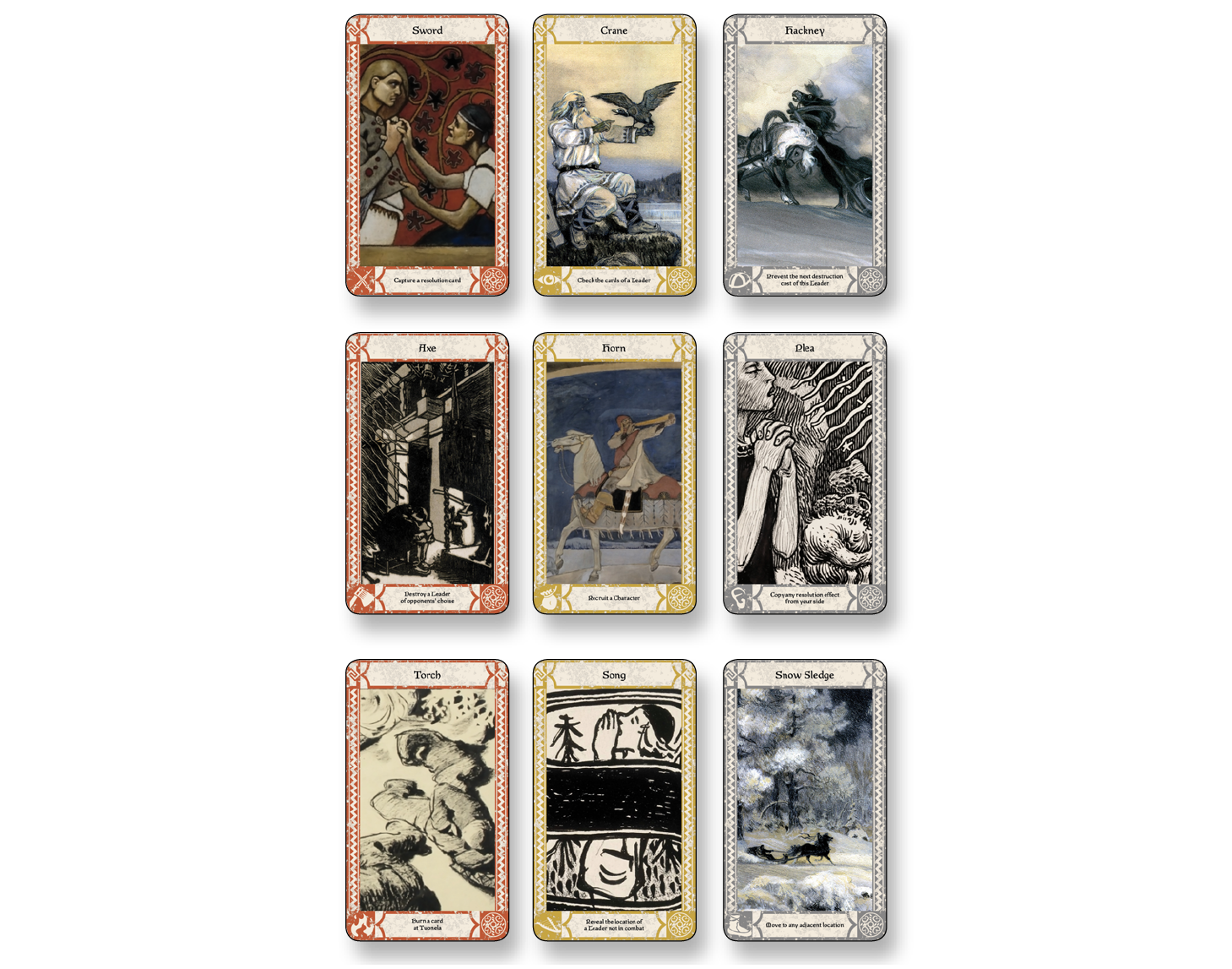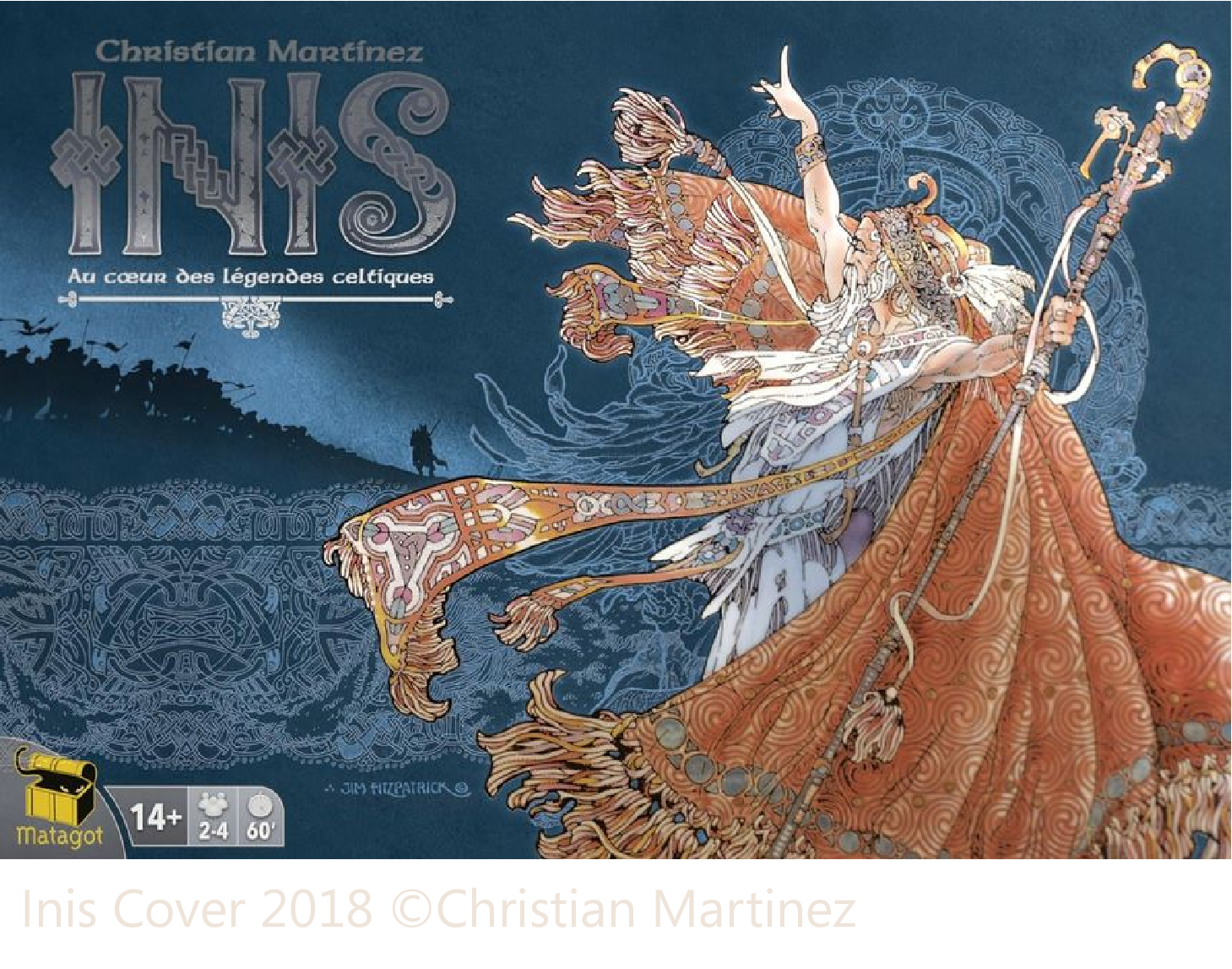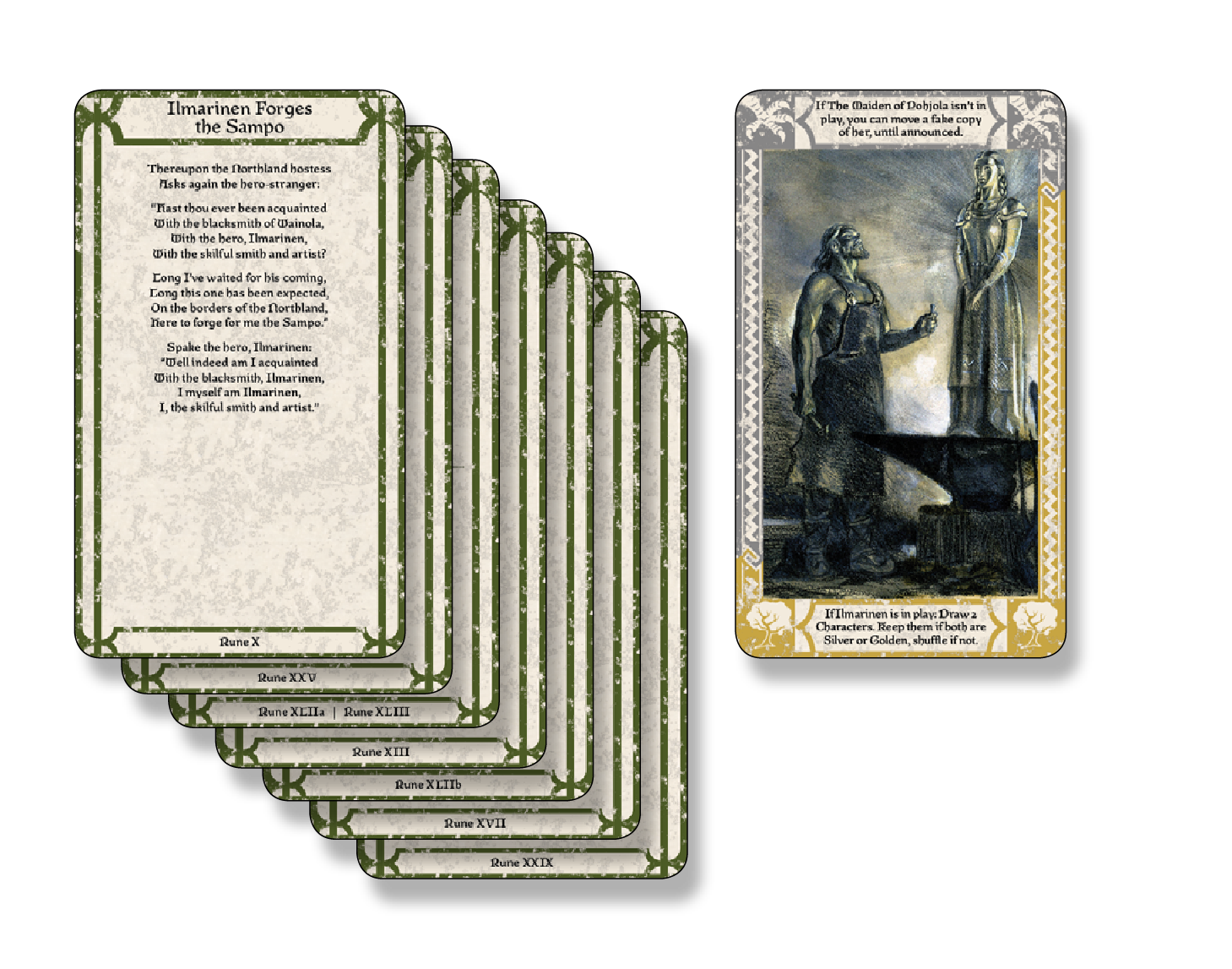Tuomas Mansikka - Game designer and psychologist
Designer’s diary
Written on 04/2020
There's no true immersion in a foreign setting and through the medium of a tabletop game without a player finding relatedness to at least one character in the game's world. Kalevala is home to a wide cast of individuals, each being susceptible to acting from an impulse. This has a few important consequences. The twists in action in Kalevala happen rapidly, and preparations are rarely made thoughtfully. Therein lies the high likelihood of tragedy, and showcases of real vulnerability.
You have a few options to find akin when you look at the roster of characters which are divided into the game's three colors: Red for Aggression, Golden for Influence, and Silver for Intrigue. Let us go through the main cast of six characters, called Leaders in the game due to their status as playable characters who can lead other characters (which aren't movable on the game map on their own) and possess tokens like a Boat or the Sampo. The Leaders are one for each color for both sides. I'll also explore how each of them can host at least two varying playstyles.
Vainola's Red Leader is Ilmarinen who may become the most fierce combatant if he forges The Northern Lights with the cost of foregoing his regular movement. If you choose Ilmarinen as the initial Sampo-bearer, you are likely preparing for a longer game. Perhaps he provides valuable support for the Sampo-bearer by being his companion? Or maybe Ilmarinen should even reverse the underlying plot line and challenge the Pohjola-Leaders to combat? Vainamoinen represents Golden Power, with the ability to sing himself new cards without cost. Whether he wants to focus on drawing combat-powerful Characters or swingy Tales is a choice fitting the wisdom of Vainamoinen; depending on the ever-changing interpretation of the board state. Lemminkainen is the Leader of Silver with a possibility for added movement. However, nothing is as fickle as his ambitions, portrayed by a D10 die roll hoping for a matching number to a helpful (it could end up being harmful too) adjacent location. He can either try to sprint to the goal line, or maybe he precedes the other Leaders and scouts for Traps in advance, or focuses on quests off the beaten path?
Pohjola's corresponding Leaders are The Landlord of Pohjola for Red, Louhi for Golden, and Iku-Turso for Silver. The Landlord does not need to destroy (Red) cards if his combat challenge succeeds. Does this mean he should be the first Pohjola-Leader to challenge on any given turn or only after some other Leader has confirmed Vainola-Leaders' whereabouts? Also, The Landlord has the capability of reaching the uncommon winning condition of destroying all opposing Leaders: if he is allowed to combat just one Leader (a duel), he can make it a combat of life and death. Louhi, on the other hand, has an ability that only activates for the rest of the game after the Sampo-bearer's location has been revealed. So, this easily leads to a thinking process of trying to challenge locations soon and often. This can however also be done by trying to force the defeated opposing Leader to reveal the Sampo-bearer and his location by playing a Golden Resource card called "Song" or more prominently, with Louhi's Power card "Wizardry". Simply the presence of Louhi will make the Vainola players hesitant on taking unnecessary risks, to avoid Louhi gaining free access to the whole map (when her ability activates, she grows wings and can move freely). Similarly, Iku-Turso is a sea monster-level of a threat, especially on water areas, where the movement of Iku-Turso is unlimited. When it is probable that a Vainola-Leader has opted for a water route, Iku-Turso is usually right there, pondering whether to challenge. Alternatively, Iku-Turso might be interested in a support role, fishing out the dead from the rivers of Tuonela, or even venturing out to activate scenarios, seemingly so far away.
Each Leader has a Power card that represents their preferred way to approach combat. This means that both sides have six Leader-related cards, two of each color, to start the game with. Both sides have a symmetric set of nine Resource cards (three of each color) to divide to their Leaders as they see fit. Resource cards are especially important to allow Leaders to use the basic actions within the game, again tied to the color of the card: Red allows for combat challenge, Golden for acquiring a new card or a Boat, Silver enables a Leader to add 1 movement point, usually adding to the regular movement. When any of these actions are completed, the appropriately colored card gets destroyed (placed to Tuonela). From this follows that both sides can strategize to lean on any of their Leaders, by dealing the Resources differently than the norm of one card of each color to each Leader (as recommended by the Learn To Play -booklet), by e.g. not giving out Resource cards identical to the Leader's color to that particular Leader. Rather, they could be allocated to a player or Leader that is expected to have a harder time or a big role (similar to "a carry" in MOBA terms) during this particular game session.
Experienced players should do what they can to help their teammates. If there are two players on a team, the novice should be given control of two Leaders compared to the experienced player's one, against what would be the intuitive way to help a novice to overcome the process of learning a completely new game. This is because this effectively doubles the chance that the novice player will find a playstyle to his liking, and to find agency in decision-making. An experienced player should react accordingly to the teammate's gameplay, and find a productive way to play out his or her Leader. Even though there are no rule changes to accommodate more players from two players up, there is no specific optimal player count. With any player count, a player has the ultimate control of at least one Leader. If you are craving for more intense play experience, you should prefer the lower player amounts, but then you might not fully be able to focus on realizing and adapting the playstyles mid-game of the multiple Leaders you control.
There's no need to do an action each turn, and there's no urgency to optimize every move like in so many other board games. All basic actions are costly, so being reckless with them might limit your further turns. The gameplay itself can still be approached relatively casually, and newcomers can sneak away with a victory. When you first learn the game, the highlight should be on the implications of the simple act of sliding your Leader magnet from one location to another. This should not come out as a surprise for those familiar with the hidden movement genre of board games.
If you are playing Vainola and escaping, you have to announce paths, one path for each Leader, but not if the announced path was utilized (traveled through) by another Leader as well. Naturally, on your first turn, this rule would suggest for Vainola to announce a path at the first path they moved through and perhaps sharing this path with multiple Leaders, as this reveals the least amount of information: Pohjola wouldn't know where they continued from there, and they risk fewer Traps (Traps are magnets that Pohjola places 12 of to various paths before the beginning of the game). However, Pohjola knows this, and thus there is a high probability for nasty Traps being waiting on the first paths away from the Pohjola-location (where every Leader starts the game from). And on the following turn, if you announce the first path of a Leader's movement route, that gives out the additional information to Pohjola where that Leader ended his turn on the previous turn, making it easier to get back on track for Pohjola (on the bigger scale).
There is also a case for each Leader to travel on its own, as then it becomes harder for Pohjola to actually locate and focus on the Sampo-bearer, initially at least. This can potentially be devastating to either side and leads to a different game experience. As all Pohjola-Leaders have one more movement point and also powerful effects that help to position them to actually successfully challenge to combat (and thus progressing towards their winning condition of reclaiming the Sampo), their movement becomes more about building up for key turns to strike down Vainola-Leaders when and where they are vulnerable. Or perhaps they challenge often with the hopes for gaining game-winning momentum. Pohjola-Leaders don't need to reveal their moved paths, so the problem with the latter approach is that it reveals information to the Vainola's side who can then utilize this information to better steer away from danger.
To round up and recap, if you are a gamer who enjoys a proactive playstyle you might be best suited with a Red Leader. And if you fancy a playstyle that has the most amount of options, a Golden Leader is recommended. Silver is good for surprises, sneakiness, and flexibility. Before the choice of a Leader you'll control, there is also the choice of which side you will want to play; the mouse (Vainola) or the cat (Pohjola). Hopefully reading this far has given you an idea of the differences between the two sides. One important aspect of the asymmetry is that the action part of turn structure is always before the movement for Vainola, and after movement for Pohjola. This means that Vainola can acquire a Boat without allowing Pohjola the chance to realize they are near water. The reverse on turn flow is because it enables Pohjola to first move to chase down Vainola, and then possibly follow-up the movement with a combat challenge if they think their current hypothesis seems probable. Due to the nature of deducing and risk-management, playing Pohjola is less about trickery and more about reasoning.
To finish up this study on the game's gameplay aspects, I felt it fair to briefly compare Kalewala: Tale of Sampo to not necessarily the games that are the most similar mechanically, but to a favorite game of mine Inis as it has had an impact on the game's design choices. Perhaps fans of that game would be fans of this game as well!
Inis is a game by Christian Martinez and published by Matagot on 2016. Inis is also a game deeply rooted in its mythological history, and it has a carefully balanced deck of cards (8/12/16/20 +1 for 2/3/4/5 players, five is only available with the expansion) that is drafted in every game, every round. However, this balance is deliberately twisted up when more and more Epic Tale cards get introduced to the game as the game session progresses. This deck of cards is so big that it is impossible to anticipate what's coming.
Kalewala: Tale of Sampo limits this effect by having a modest deck of Prologue Tales which includes 7 swingy effects for both sides. More get introduced through the game's Memory system, but only a maximum of one new Tale gets added in every game. Each added (narrative) Tale corresponds to the specific style by which that gaming session was one with. You might see the similarity between these two games or not, but the social dynamic of playing these two games is something I personally cherish in a similar way. In Kalewala: Tale of Sampo, this experience is more condensed to fit a tighter time window of a playtime running between 30 and 60 minutes. I find it worthwhile to try to be inspired by your own idols and even trump them when you are making your own design as great as you possibly can!
Let me hear what you think!








